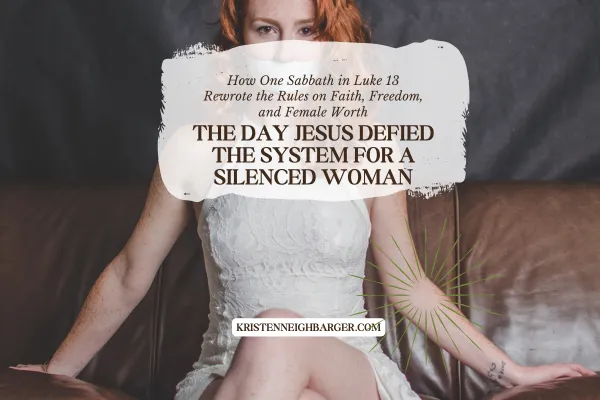
The Day Jesus Defied the System for a Silenced Woman
I stared wide-eyed at the woman in front of me, willing myself to keep my face neutral while my mind raced.
“I mean, I create all the floral arrangements for our services. We’re not like those churches that don’t let women do anything.”
Smile, Kristen. Smile, I coached myself silently. Don’t say anything offensive. Just nod, excuse yourself, and back away slowly.
As she continued talking—listing off the many ways women could “serve” in her church (nursery duty, baking communion bread, decorating classrooms)—I stopped hearing her words. All I could hear was the voice of the teacher from the old Peanuts cartoons.
As soon as she looked down to find photos of her flower arrangements, I made my exit.
“Thanks for sharing with me—I need to get going,” I said, slipping away before she could pull me into any more examples of how her church let women do things.
Recognizing Religious Harm Without Saying a Word
When I tell people I help survivors of spiritual abuse and religious trauma reconstruct a shame-free faith, their body language tells me everything I need to know.
Some exhale in visible relief. Others stiffen. Some get curious. Others defensive.
This particular woman didn’t wait for elaboration. Just hearing who I wrote for prompted her to justify her church’s position on women before I even brought it up. It was like she had been trained to defend the system. Especially when it came to gender.
I walked away—not angry this time, just…sad.
Sad because I saw my former self in her. I too once defended what I didn’t know was harming me. I too believed women’s “roles” in the church were a divine design, not a distorted cultural inheritance.
The Gendered Double Life I Lived
In the world, I was told I could be anything: strong, smart, ambitious. But in the church? I was told to be submissive, silent, and safe. I could cook, sing, clean, and teach women and children—as long as a man was nearby to lead.
Let me be clear: There’s nothing wrong with any of those contributions. But when the church teaches that’s all women are permitted to do, it’s not just limiting—it’s spiritually damaging.

Why Context Matters: Jesus, Women, and the Weight of Luke 13
I grew up hearing that “all Scripture is God-breathed,” but ironically, I was rarely taught the context God breathed it into.
Let’s look at Luke 13:10–17:
On the Sabbath, Jesus was teaching in the synagogue when he noticed a woman who had been bent over for eighteen years. He called her forward, laid hands on her, and said,
“Dear woman, you are free. I release you from your infirmity.”
Immediately, she stood tall and began praising God.
The synagogue leader was furious—not because she was healed, but because it happened on the Sabbath.
Jesus replied, “You hypocrites! Don’t you untie your animals to lead them to water on the Sabbath? Shouldn’t this daughter of Abraham be untied from what has bound her for eighteen years?”
Growing up, this story was mostly used to illustrate Pharisaical hypocrisy. The irony? The sermon always focused on Jesus and the male leaders. The woman? Barely mentioned.
But let’s look closer at her story.
Historical, Cultural, and Religious Context of Luke 13:10–17
To understand just how radical Jesus' actions were, we have to understand what this woman was up against.
👵️ Gender and Social Hierarchy
In first-century Jewish society, women were not treated as equals to men socially, legally, or religiously. Although the Hebrew Bible includes strong female figures, much of rabbinic Judaism by Jesus’ time had grown increasingly patriarchal:
A woman’s identity was tethered to her father or husband. She had no independent legal standing.
Education in the Torah was typically reserved for men. A popular rabbinic saying from the era was:
“It is better that the words of the Torah be burned than be entrusted to a woman.”Participation in synagogue life was passive and segregated. Women were allowed to be present but were usually confined to separate sections and not permitted to read aloud, teach, or lead.
Women could contribute within limited roles, but their voices were not valued in matters of spiritual authority or public teaching.
🧼 Disability and Spiritual Stigma
In addition to her gender, this woman had been physically disabled for eighteen years. Luke describes her as being "bent over," which some scholars believe refers to a spinal condition like kyphosis or spondylitis.
But beyond the physical limitations, there were spiritual and social consequences:
Many people at the time believed suffering was caused by sin—either your own or your family's. Though Jesus repeatedly challenged this theology (see John 9 or Luke 13:1–5), it remained deeply ingrained.
People with visible ailments were often marginalized or shunned. Their presence could be considered a disruption to the ritual purity of the synagogue space.
This woman wasn’t just ignored because she was female—she was treated as spiritually suspect. Present, but invisible.
⛪️ Religious Authority and the Sabbath
The fact that Jesus healed her on the Sabbath matters—deeply.
The Sabbath was not just a day of rest; it was a marker of Jewish identity and obedience. The Pharisees had detailed oral laws outlining what “work” meant, and healing was generally considered work unless someone’s life was at risk.
So Jesus healing this woman wasn't just a compassionate act—it was a direct challenge to the religious leaders’ interpretation of the law. He was claiming authority over the Sabbath itself.
When the synagogue leader reprimands the crowd for seeking healing on the Sabbath, he reveals the heart of the system: preserving order over people.
Jesus calls him out, comparing their care for animals to their lack of care for this woman. That would’ve been a public humiliation in a male-dominated honor culture.

🔥 Why “Daughter of Abraham” Is Revolutionary
When Jesus calls her a “daughter of Abraham,” He’s doing several things at once:
Restoring her dignity publicly—He names her, blesses her, and refuses to let her identity be defined by her suffering.
Giving her covenant status—The phrase “son of Abraham” was common; “daughter of Abraham” was unheard of. He was claiming her as a full heir to the promises of God.
Undermining patriarchal norms—This was not a quiet, backroom healing. It was public, on sacred ground, in direct opposition to the male authorities present.
Re-centering her in the story—Jesus makes her the theological pivot point of the passage. She becomes the lens through which we see what true Sabbath, true holiness, and true freedom look like.
We Still Need This Disruption
Despite Jesus’ clear affirmation, many churches today still relegate women to the periphery. Still silence their voices. Still prioritize tradition over transformation.
We mock the Pharisees for clinging to rules, but then do the same when we uphold outdated cultural structures as if they’re gospel.
Jesus didn’t just heal this woman—He restored her to the center. He didn’t just defy religious legalism—He redefined holiness as liberation.
It’s time we followed His lead.
✨ Reflection Questions
Where have I accepted roles or limits that were never God-ordained?
How have I witnessed or justified gender-based exclusion in my church experience?
What would it look like to center the marginalized in my faith community the way Jesus did?

🔥 Call to Action
If you’ve ever been told your voice doesn’t belong in the church—or if you’re deconstructing harmful teachings you were raised on—you’re not alone. Jesus saw that woman, called her forward, and redefined her place in the story.
He does the same for you.
🖘 Share this post if you’ve ever been bent under the weight of silence.
💬 Comment below: What would it mean for you to stand tall again?
🌿 Looking for fresh inspiration and real connection with fellow writers?
The Hope Story Conference is happening January 29–31, 2026 in Charlotte, North Carolina, and it’s one of my favorite spaces for writers who want to grow in both craft and calling. With keynote speakers like Ruth Chou Simons and Ann Voskamp, you’ll leave refreshed, equipped, and reminded that your story truly matters.
It’s a weekend filled with practical workshops, meaningful community, and encouragement for every stage of the writing journey.
👉 Grab your ticket here: Hope Story Conference
(That’s my affiliate link—thank you for using it to support my work!)

